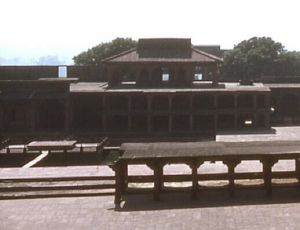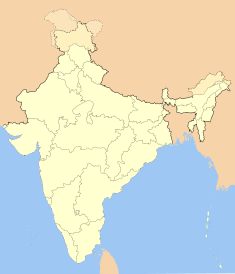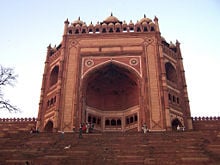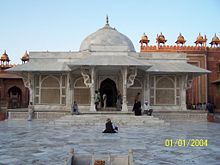Fatehpur Sikri
| Fatehpur Sikri* | |
|---|---|
| UNESCO World Heritage Site | |
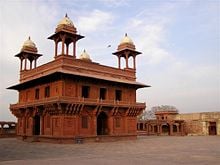
| |
| State Party | |
| Type | Cultural |
| Criteria | ii, iii, iv |
| Reference | 255 |
| Region** | Asia-Pacific |
| Inscription history | |
| Inscription | 1986 (10th Session) |
| * Name as inscribed on World Heritage List. ** Region as classified by UNESCO. | |
Fatehpur Sikri(Hindi: फतेहपूर सिकरी, Urdu: فتحپور سیکری), a city and a municipal board in Agra district in the state of Uttar Pradesh, India, served as capital of India's Mughal Empire under Akbar's reign, from 1571 until 1585. Located in Uttar Pradesh, Akbar abandoned the city, ostensibly due to lack of water.
History and Significance
Built by Mughal emperor Akbar in honor of Sufi saint Salim Chishti in 1571, the fort situates at 27° 05' N latitude and 77° 39' E longitude, at a mean altitude of 708 meters above sea level. Fatehpur Sikri shared its imperial duties as a capital city with Agra, where the Red Fort safe guarded a bulk of the arsenal, treasure hoards, and other reserves. During a crisis, the court, harem, and treasury could be removed to Agra, only twenty six miles away, less than a day's march.
Innovations in land revenue, coinage, military organization, and provincial administration emerged during the Fatehpur Sikri years. Regarded as Emperor Akbar's crowning architectural legacy, its numerous palaces, halls, and masjids satisfied his creative and aesthetic impulses, typical of Mughals.
UNESCO designated Fatehpur Sikri a World Heritage Site. Some contemporary Indian architects, notably B. V. Doshi, have cited it as an important source of inspiration. Architect or layperson, the city generally captures the imagination and wonder of all who experience its urban spaces and see its buildings. Charles and Ray Eames, cited Fatehpur Sikri in the landmark 'India Report' that led to the conception of the National Institute of Design, India's premiere design school. [1]
It is here, that the legends of Akbar and his famed courtiers, the nine jewels or navaratnas, were born. The legendary musician Tansen is said to have performed on an island in the middle of the tank Anup Talao (lit. anup= without metaphor, unmatched). Eventually, it is believed that water sources dried up and the fort had to be abandoned.
Design
| Fatehpur Sikri Uttar Pradesh • India | |
| Coordinates: | |
| Time zone | IST (UTC+5:30) |
| District(s) | Agra |
| Population | 28,754 (2001) |
Coordinates:
The layout of the city shows a conscious attempt to produce rich spatial effects by the organization of built forms around open spaces in interesting ways. Of particular note is the way in which shifts in axes occur as one moves along the city and the location of squares in important places with buildings forming a backdrop or envelope.
Unlike other important Mughal cities (such as Shahjahanabad, which has a very formal planning), Fatehpur Sikri has aspects of informality and improvisation. Indeed, the newly constructed city bore a similarity to the movable imperial encampment also designed by Akbar.
Important buildings
The buildings of Fatehpur Sikri show a synthesis of various regional schools of architectural craftsmanship such as Gujarati and Bengali. This was because indigenous craftsmen from various regions were used for the construction of the buildings. Influences from Hindu and Jain architecture are seen hand in hand with Islamic elements. The building material predominantly used is red sandstone, quarried from the same rocky outcrop on which it is situated. Among the buildings, three stand out: Panch Mahal, Buland Darwaza, and the Tomb of Salim Chisti.
Panch Mahal
Panch Mahal: A five-storied palatial structure. The bottom floor has 176 intricately carved columns. Also known as "Badgir," which means windcatcher/tower. Panch Mahal stands close to the Zeenana quarters or Harem and that consolidates the fact that it acted as a pleasure palace. This is an extraordinary structure, entirely columnar, consisting of four storys of decreasing size disposed asymmetrically upon a ground floor, which contains 84 columns. The pillars that originally had Jaalis between them support the whole structure.Once these screens provided purdah (cover) to queens and princess on the top terraces enjoying the cool breezes and watching splendid views of Sikri fortifications and the town nestling at the foot of the ridge.
The pavilion gives a majestic view of the fort that lays on its left. it is built by akbar and only took 10 years to build the whole city.
Buland Darwaza
Buland Darwaza – the 'Gate of Magnificence' (Hindi: भुलन्द् दरवज़ा), one of the gateways to the Jami Masjid, a stupendous piece of architecture from the outside, gradually making a transition to a human scale in the inside. Built by Akbar in 1602 to commemorate his conquest of Gujarat. The gateway is approached by 42 steps. The Buland Darwaza is 53.63m high and 35 meters wide. Buland Darwaza is the highest gateway in the world and an astounding example of the Mughal architecture. It is built of red sandstone and inlaying of white marble. There is an inscription on the monument which is a message from Jesus advising his followers not to consider this world as their permanent home.
The Buland Darwaza towers above the courtyard of the mosque. The Buland Darwaza is semi octagonal in plan and is topped by pillars and chhatris. Buland Darwaza echoes early Mughal design with simple ornamentation, carved verses from the Koran and towering arches. There are thirteen smaller domed kiosks on the roof, stylized battlement and small turrets and inlay work of white and black marble. On the outside a long flight of steps sweeps down the hill giving the gateway additional height. A Persian inscription on eastern archway of the Buland Darwaza records Akbar's conquest over Deccan in 1601 C.E.
Tomb of Salim Chisti
Tomb of Salim Chisti: a white marble encased tomb within the Jama mosque's courtyard.
Shaikh Salim Chisti (Urdu: شيخ سلیم چشتی ) was Sufi saint during Mughal Empire empire in South Asia. Salim Chishti (1478-1572) was one of the famous Sufi saints of the Chishti Order in India. Salim Chisti was the descendant of the famous Khawaja Moinuddin Chishti whose tomb is in Ajmer, Rajasthan.
Salim Chisti was a greatly revered Sufi Mystic who, it was thought by many, could perform miracles. The Mughal Emperor Akbar-e-Azam came to the holy man's camp, deep in the desert, seeking a male heir to his throne. Salim Chisti blessed Akbar, and soon the first of three sons was born to him. He named his first son Salim (later emperor Jahangir) in honor of Salim Chisti. Akbar held the Sufi in such high regard that he had a great city Fatehpur Sikri built around the Sufi Saint's camp.His Mughal Court and Courtiers were then relocated here. A shortage of water is said to be the main reason the city was abandonded and now sits in remarkably good condition as a, mostly, deserted city. Now it is one of the main tourist attractions of India. The tomb of Shaikh Salim earlier it was built with red sand stone but later converted into beautiful marble mauseleum ,currently his descendant Khursheed Aleem Chishti lives here and maintains the Mazar.
Salim Chisti's Mazar (tomb) is in the middle of The Emperor's Courtyard at Fatehpur Sikri, Uttar Pradesh, India. Childless women, particularly those without a male heir, still continue to pray on bended knees before his tomb. Such is the power of legends.
It is believed that offering prayers at this Mazar File:\My Photo\AGRA TRIP 21 02 2008\100 4539.jpg whatever one wishes will gets definitely fulfilled by the will of Salim Chisti himself. There is also a ritual of tying a thread at the marble windows of this Dargah to fulfill the wishes. Any Individual can see many threads tied there.The ancestral house of shaikh salim chisti is behind the first building built in Fatehpur Sikri which is known as "Sangtarash mosque" or Stone Cutter's mosque is one of the oldest buildings in Fatehpur Sikri, Stone Cutter's mosque is situated to the west of the Jami Masjid,which was build by the local stone cutters in honour of salim chisti It has some beautiful architectural traits marking the incorporation of indigenous architectural styles in the construction this is the mosque where salim chisti spend most of his time in between number of hajj he performed. Salim Chisti's mazar is one of the best accomplishment of Mughal architecture, surpassed only in reputation and is flanked by the massive gate Buland Darwaza or Victory gate on the southern side Badshahi darwaza or Emperors gate on eastern side and a grand mosque Jama masjid on western side with courtyards, reflecting pool and other tombs commenced in 1571 the work was completed fifteen years later.
Other Important Buildings
Some other important buildings in this city, both religious and secular buildings follow:
- Naubat Khana – Drum house: near the entry, where important arrivals are announced.
- Diwan-i-Am – Hall of Public Audience: a building typology found in many Mughal cities where the ruler meets the general public. In this case it is a pavilion like multi-bayed rectangular structure fronting a large open space.
- Diwan-i-Khas – Hall of Private Audience: famous for its central pillar with thirty-six voluted brackets supporting a circular platform for Akbar.
- Raja Birbal's house: the house of Akbar's favourite minister, who was a Hindu. Notable features of the building are the horizontal sloping sunshades or chajjas and the brackets which support them.
- Jodhabai's palace: The building shows Gujarati influence and is built around a courtyard, with special care being taken to ensure privacy.
- Pachisi Court: a square marked out as a large sized board game (modern day Ludo) where live coins- people- participated.
- Char Chaman Tank: a tank with a central platform and four bridges leading up to it.
- Jama Masjid: the mosque, built in the manner of Indian mosques, with liwans (aisles) around a central courtyard. A distinguishing feature is the row of chhatris (small domed pavilions) over the sanctuary.
Demographics
As of 2001 India census[2], Fatehpur Sikri had a population of 28,754. Males constitute 53% of the population and females 47%. Fatehpur Sikri has an average literacy rate of 46%, lower than the national average of 59.5%: male literacy is 57%, and female literacy is 34%. In Fatehpur Sikri, 19% of the population is under 6 years of age.
Gallery
Notes
ReferencesISBN links support NWE through referral fees
- Bahn, Paul G. 1999. Lost cities. New York: Welcome Rain. OCLC 41272747.
- Eames, Charles, and Ray Eames. 1997. The India Report, April 1958. Ahmedabad: National Institute of Design. OCLC 214289398.
- Gaur, R. C. 2000. Excavations at Fatehpur Sikri: a national project. New Delhi: Aryan Books International. ISBN 9788173051784.
- Nath, R., and R. Nath. 1988. Architecture of Fatehpur Sikri: forms, techniques & concepts. Jaipur, India: Historical Research Documentation Programme. ISBN 9788185105093.
- Petruccioli, Attilio, and Thomas Dix. 1992. Fatehpur Sikri. Berlin: Ernst & Sohn. ISBN 9783433027059.
- Sharma, D. V. 2008. Archaeology of Fatehpur Sikri: new discoveries. New Delhi: Aryan Books International. ISBN 9788173053221.
External links
- Fatehpur Sikri in UNESCO List. Retrieved July 8, 2008.
- Guide to Fatehpur Sikri. Retrieved July 8, 2008.
- - photographs of Fatehpur Sikri and other sites of UP. Retrieved July 8, 2008.
- UNESCO Virtual Tour of the Monuments at Fatehpur Sikri. Retrieved July 8, 2008.
- Pictures of Fatehpur Sikri. From a backpackers trip around India in 2005.. Retrieved July 8, 2008.
- Pictures of Fatehpur Sikri - Terra Galleria. Retrieved July 8, 2008.
| |||||||||||||||||||||||
| |||||||
Credits
New World Encyclopedia writers and editors rewrote and completed the Wikipedia article in accordance with New World Encyclopedia standards. This article abides by terms of the Creative Commons CC-by-sa 3.0 License (CC-by-sa), which may be used and disseminated with proper attribution. Credit is due under the terms of this license that can reference both the New World Encyclopedia contributors and the selfless volunteer contributors of the Wikimedia Foundation. To cite this article click here for a list of acceptable citing formats.The history of earlier contributions by wikipedians is accessible to researchers here:
- Fatehpur_Sikri history
- Salim_Chishti history
- Buland_Darwaza history
- Panch_Mahal_Fatehpur_Sikri history
The history of this article since it was imported to New World Encyclopedia:
Note: Some restrictions may apply to use of individual images which are separately licensed.
